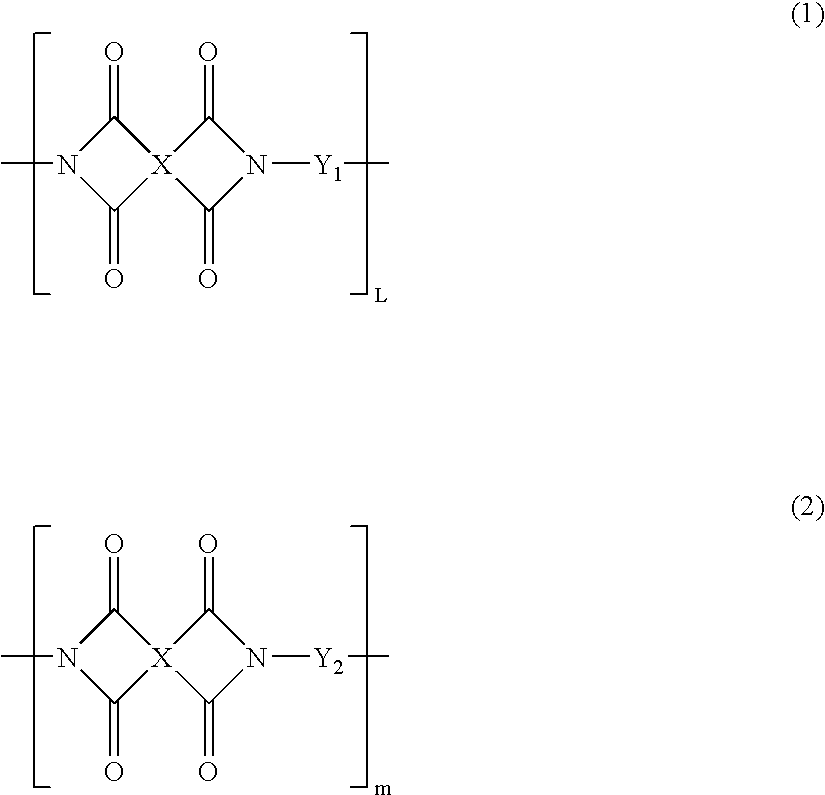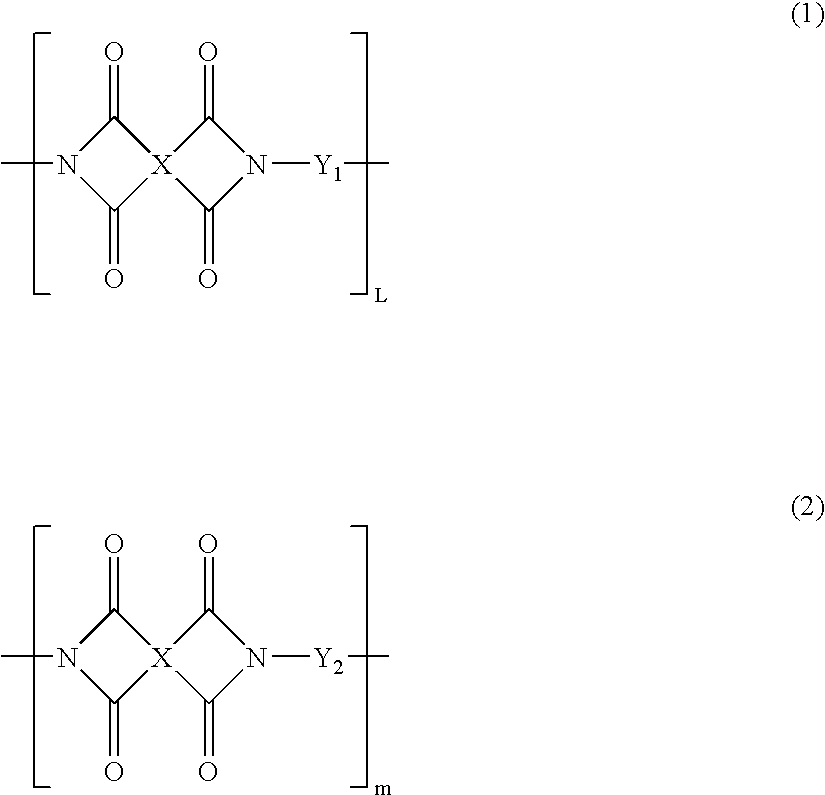Partial block polyimide-polysiloxane copolymer, making method , and resin composition comprising the copolymer
a polyimide polysiloxane and polyimide polyacrylate technology, applied in the field of partial block polyimidepolysiloxane copolymers, can solve the problems of resin deformation, chip cracks or thermal degradation, film has a lower glass transition temperature, etc., and achieves low modulus of elasticity and improved adhesion.
- Summary
- Abstract
- Description
- Claims
- Application Information
AI Technical Summary
Benefits of technology
Problems solved by technology
Method used
Image
Examples
example 1
[0159] A 1-liter separable flask equipped with a reflux condenser, a Dean-Stark trap, a thermometer and a stirrer was charged with 53.31 pbw of 6FDA as an acid dianhydride component and 418 pbw of cyclohexanone, which were stirred at 50° C. for dispersing the acid dianhydride. To the dispersion, 86.00 pbw of diaminosiloxane KF-8010 (both end γ-aminopropyl-dimethylsiloxy-blocked dimethylpolysiloxane, weight average molecular weight 860, Shin-Etsu Chemical Co., Ltd.) as a diamine component was added dropwise. The mixture was stirred for 12 hours at room temperature for reaction, synthesizing a polyamic acid oligomer solution #1. The solution, to which 40 ml of toluene was added as a dehydrating solvent, was heated and dehydrated at about 160° C. for 8 hours, with about 3.6 ml of water being distilled off. This yielded an acid anhydride-terminated polyimide oligomer solution #1.
[0160] The solvent was distilled off from the resin solution, followed by vacuum drying. The resulting resin...
example 2
[0167] A 1-liter separable flask equipped with a reflux condenser, a Dean-Stark trap, a thermometer and a stirrer was charged with 45.11 pbw of BTDA as an acid dianhydride component and 445 pbw of cyclohexanone, which were stirred at 50° C. for dispersing the acid dianhydride. To the dispersion, 103.20 pbw of diaminosiloxane KF-8010 (Shin-Etsu Chemical Co., Ltd.) as a diamine component was added dropwise. The mixture was stirred for 12 hours at room temperature for reaction, synthesizing a polyamic acid oligomer solution #3. The solution, to which 40 ml of toluene was added as a dehydrating solvent, was heated and dehydrated at about 160° C. for 8 hours, with about 4.3 ml of water being distilled off. This yielded an acid anhydride-terminated polyimide oligomer solution #3.
[0168] The solvent was distilled off from the resin solution, followed by vacuum drying. The resulting resin was analyzed by IR absorption spectroscopy, detecting absorption peaks attributable to imide radicals a...
example 3
[0173] A 1-liter separable flask equipped with a reflux condenser, a Dean-Stark trap, a thermometer and a stirrer was charged with 59.36 pbw of a phenolic hydroxyl radical-containing aromatic diamine (Diamine-1) of the formula:
as a diamine component and 311 pbw of cyclohexanone, which were stirred at 50° C. for dissolution. To the solution, 44.42 pbw of 6FDA as an acid dianhydride component was added in small divided portions. The mixture was stirred for 12 hours at room temperature for reaction, synthesizing a polyamic acid oligomer solution #5. The solution, to which 40 ml of toluene was added as a dehydrating solvent, was heated and dehydrated at about 160° C. for 8 hours, with about 3.6 ml of water being distilled off. This yielded an amino-terminated polyimide oligomer solution #5.
[0174] The resin was similarly isolated and analyzed by IR absorption spectroscopy, detecting absorption peaks attributable to imide radicals at 1770 cm−1 and 1720 cm−1 and an absorption peak attr...
PUM
| Property | Measurement | Unit |
|---|---|---|
| Adhesion strength | aaaaa | aaaaa |
| Elasticity | aaaaa | aaaaa |
Abstract
Description
Claims
Application Information
 Login to View More
Login to View More - R&D
- Intellectual Property
- Life Sciences
- Materials
- Tech Scout
- Unparalleled Data Quality
- Higher Quality Content
- 60% Fewer Hallucinations
Browse by: Latest US Patents, China's latest patents, Technical Efficacy Thesaurus, Application Domain, Technology Topic, Popular Technical Reports.
© 2025 PatSnap. All rights reserved.Legal|Privacy policy|Modern Slavery Act Transparency Statement|Sitemap|About US| Contact US: help@patsnap.com



